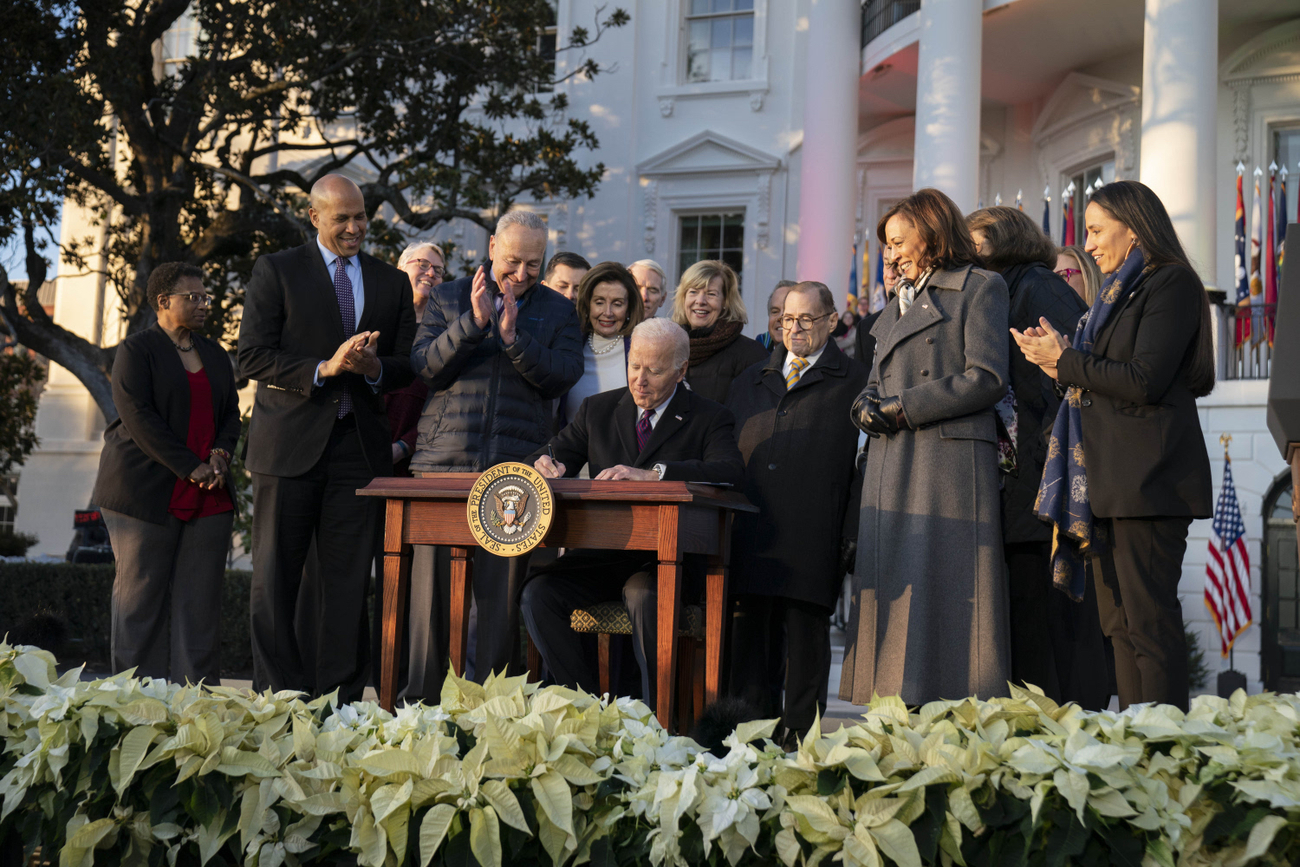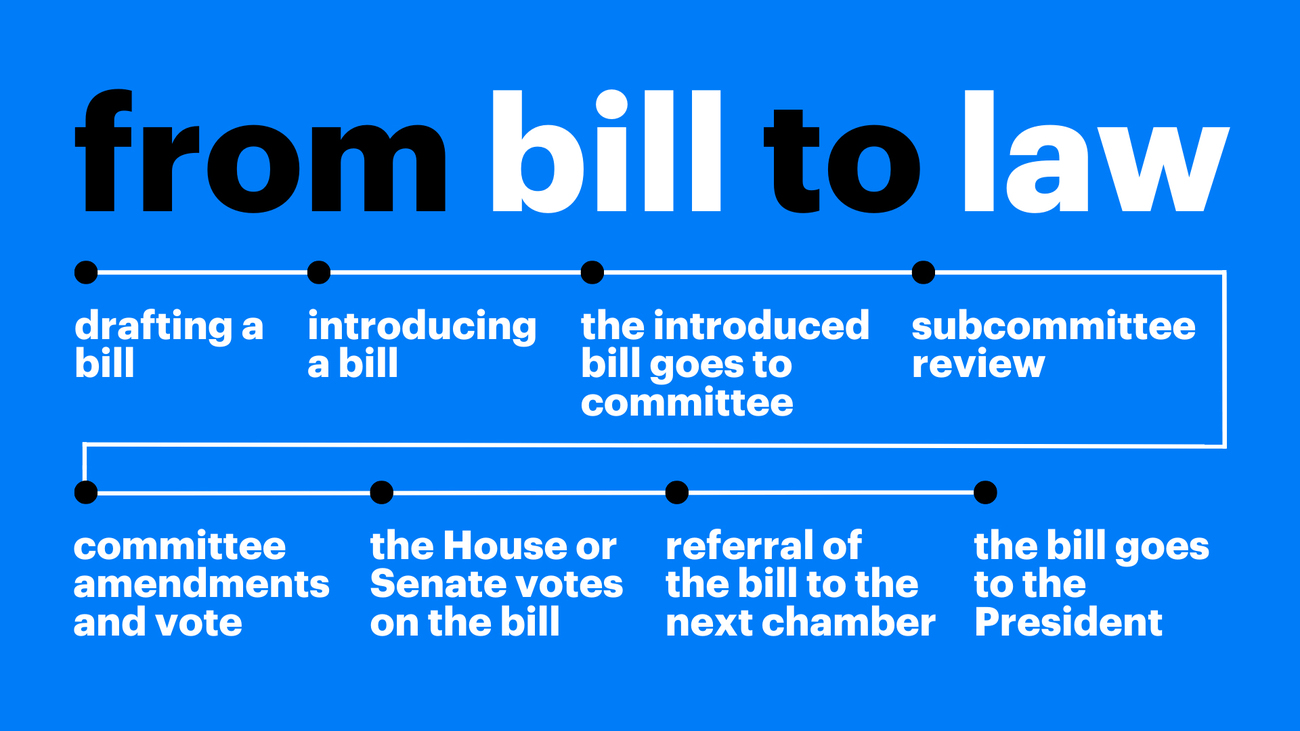how a bill becomes law
how a bill becomes law

In the United States, most federal laws begin as bills in the U.S. Congress. There are many steps in the legislative process that a bill may undergo on the way to becoming a law. The U.S. Constitution requires that a successful bill pass both houses of Congress (the House of Representatives and the Senate) before being presented to the President to be signed into law.

Take, for example, the Big Cat Public Safety Act (BCPSA). The BCPSA prohibits keeping tigers, lions, cougars and other big cats as “pets,” and prohibits dangerous public contact with these species. Versions of the bill were proposed in multiple Congresses—with each Congress lasting for two years—but did not make it through all of the steps required to become law until 2022.
drafting a bill
Members of Congress are involved in the first stage of putting ideas for laws into action. Although citizens or advocacy groups can propose an idea, they must work with members of Congress to initiate the legislative process.
Once a policy objective is identified, a member (or, in many cases, multiple members) of Congress determines whether a new law could provide for a way to meet that objective. Considerations include but are not limited to whether the new law would be enforceable, is within the limits of the Constitution, the can be achieved by better enforcing an existing law. Then, the process of drafting a bill begins. The member(s) of Congress who leads introduction of a bill is referred to as the bill’s “sponsor,” with other members of the relevant chamber who formally support the bill being added as “cosponsors.”
In the case of the BCPSA, this process began in the House of Representatives, with Congressmen Mike Quigley (D-IL) and Brian Fitzpatrick (R-PA) as the lead sponsors, joined by six more bipartisan “original cosponsors” upon introduction and ultimately joined by more than half of the U.S. House by the time the bill passed in that chamber.
introducing a bill
The drafted bill must be introduced to the chamber of Congress in which the sponsor is a member (either the House or the Senate), or it may be introduced in both chambers, as was the case with the BCPSA. The BCPSA was introduced to the House of Representatives on January 11, 2021 and in the U.S. Senate on April 19, 2021.
the introduced bill goes to committee
When a bill is introduced, it is referred to a committee. Committees in each chamber typically include members of Congress who have a particular interest in the issues over which the committee has jurisdiction. The committee generally must approve bills before they move forward to consideration by the full chamber. Congressional committees may hold hearings on bills that are referred to them, which provides members with a formal opportunity to hear from experts and stakeholders as they consider advancing proposed legislation.
The BCPSA was referred to the House Committee on Natural Resources and to the Senate Committee on Environment and Public Works following its introduction in each chamber.
subcommittee review
The bill may be referred to a smaller, more specialized committee—a subcommittee—nested within the larger committee. The subcommittee may choose to hold additional hearings and revise the bill, and may vote to support the bill before it returns to the full committee for consideration.
The BCPSA was referred to the Subcommittee on Water, Oceans, and Wildlife—a subcommittee of the House Committee on Natural Resources—following its introduction, and the subcommittee held a hearing and voted to return the bill to the full committee during summer 2022.
committee amendments and vote
If a bill is approved by the relevant subcommittee, the larger committee may consider advancing it to the full chamber. Members of the committee may make further changes or amendments to the proposed legislation. The committee will then vote to send the bill to the full House or Senate. If the committee votes not to send the bill to the full chamber, the bill dies.
The House Committee on Natural Resources voted to advance the BCPSA on June 15, 2022.
the House or Senate votes on the bill
Once the bill is approved by the appropriate committee(s), it may be taken up for consideration by the full House or Senate, and members of that chamber may debate its merits and make further amendments. The bill may then be put up for a vote.
The BCPSA was debated on the floor of the House of Representatives on July 28, 2022 and passed by a vote of 278-134 the following day.
referral of the bill to the next chamber
If the bill passes one chamber of Congress, it will move to the next chamber, which must also approve the measure if it is to become law. The second chamber can approve the bill as passed by the first, make changes, or reject it entirely. If the bill undergoes additional changes before passing both chambers of Congress, the House and Senate may form a committee to resolve the differences between the two chambers’ versions. If leaders from the two chambers cannot agree on a final form of the bill, the bill may not move forward. If the House and Senate agree on a final draft of the bill, it will return to each chamber for another vote.
The BCPSA was received in the Senate on August 1, 2022, and that chamber passed the measure without changes on December 6, 2022.
the bill goes to the President
The final draft of the bill is sent to the President, who either signs it into law or vetoes it. If the President does not take action within ten days of being presented with a bill and while Congress is in session, it becomes law.
President Biden signed the BCPSA into law on December 20, 2022.
Related content
every problem has a solution, every solution needs support.
The problems we face are urgent, complicated, and resistant to change. Real solutions demand creativity, hard work, and involvement from people like you.